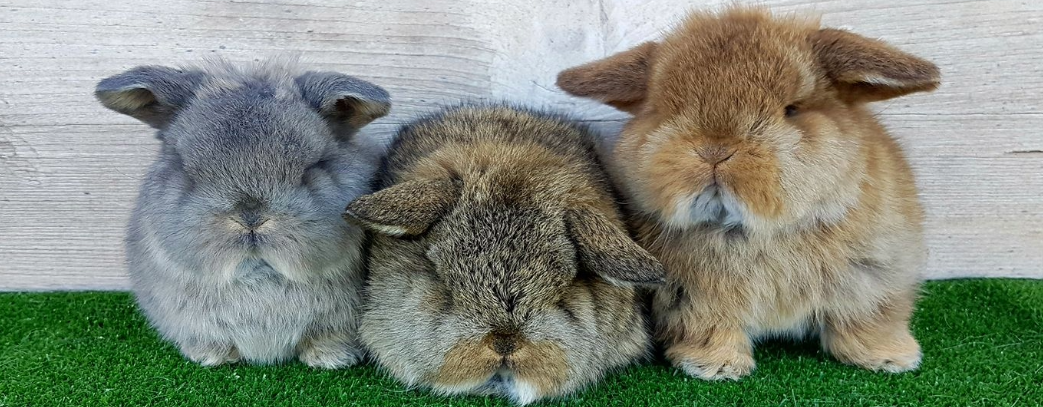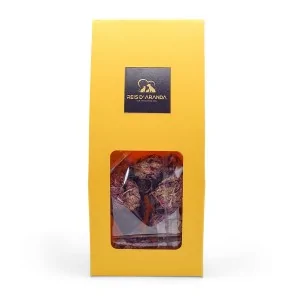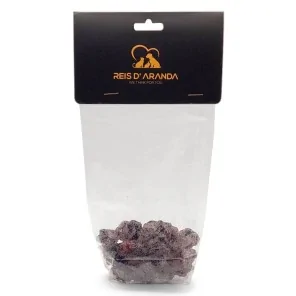Its name says it all: the Vienna blue rabbit comes from Austria. Not only is it beautiful with its shiny blue-grey...
THE MINI LOP RABBIT
THE MINI LOP DWARF RABBIT
The Mini Lop (also called "Miniature Belier") is the smallest lop-eared breed in existence, although some Lion Lop (Lionhead Belier) lines are vying for that position. This adorable creature with full cheeks, bright eyes and an expression of absolute sweetness is the most popular breed as a pet, although its presence is minimal as are many other breeds in countries such as Spain and Italy. The countries where they are most popular are the United Kingdom, Russia and the United States. They are characterised by a short and strong body, with short legs and robust head, their adult weight is between 1.500kg and 1.600kg.
THE MINI LOP STANDARD
The standard (breed regulations) which follows is the one applied in Spain and is the same as the one used in the United Kingdom (BRC).
1. TYPE - The type should be defined, sound and firm. The body should be short, broad and well muscled, with little visible neck. The croup should be short and rounded. The chest is broad and deep with curved sides at the point of attachment to the shoulders, which are broad and strong. The forelegs are thick, short and straight. The hind legs are short, strong and powerful, parallel to the body. The tail is straight, strong and hairy. A small dewlap is permissible, but not having a dewlap is more desirable.
2. ADULT WEIGHT - The ideal weight is between 1500 gr (1.5 Kg) and 1600 gr (1.6 Kg). The maximum weight for a junior (less than 5 months) is 1360 gr.
3. HAIR - The coat should be dense and of correct length, presented in a downward direction. Paws and pads should be well coated with hair.
4. HEAD, NECK AND EYES - The head should be well defined, broad and well developed. The profile of the head is slightly curved, with good width between the eyes, protruding zygomatic bones and broad muzzle. The eyes are large, well developed and bright. The base of the ears should be prominent along the upper portion of the skull, to form the nape of the neck.
5. EARS - Should be broad, well furred and rounded at the tips. Set close to the zygomatic bones, forming a horseshoe shape when viewed from the front. The inside of the ears should not be visible from any angle.
6. COLOUR AND PATTERN - Any colour or pattern accepted by the Breed Standards Committee of the British Rabbit Council with the exception of the Broken pattern, which is not recognised for showing. However, the butterfly pattern is permitted, differing from the broken pattern only in the amount of white hair on the specimen (more white hair than coloured hair would be a broken which would not be entered for show).
MODEL/PATTERN OF THE BUTTERFLY
The colour of the butterfly should be well marked on the nose, completely covering the nose and upper lip. The white markings on the head should be in proportion to the body colours. The colour of the ears should match the body colour. Body colour extending from tail to shoulders, white patches on shoulders permissible. Body colour extends to flanks. Flank, chest and belly white, patches on nipples permissible. White must generally be present on the body.
BUTTERFLY FAULTS: White spot on nose, upper lip and body markings.
MANTLE AND BROKEN
As a rule they are not showable.
Mantles have a face entirely of one colour or possibly with only a white blaze on the head, colour entirely on the shoulders. Usually a mixture of colour on the body and white on the chest.
The broken is predominantly white on the body and face, with a few dots of colour (vice versa of the mantle as to proportion of colour).
7. CONDITION - The dog should be in perfect health and good physical condition, free from any dirt, especially on legs, ears and sexual organs. The coat should reflect the general good health of the dog, which should appear alert and vigorous.
FAULTS - Body too elongated, head not sufficiently characteristic of the breed, injured or damaged ears, poor ear position, folded ears, never undeveloped, hair not returning to its original position when moved by hand in the opposite direction, large dewlap in bitches, hind legs not parallel to body, slight dirt on legs, ears and sexual organs, hairless pads, slightly dirty or thinned hair, long nails, lack of vitality.
DISQUALIFICATIONS - Abnormal or mutilated teeth, specimens over the weight limit, deformation of teeth (malocclusion), ears with tips turned back, crooked or bent legs, deformed tail, any visible ailment or disease, total or partial blindness, incorrect eye colour, any parasitic infection, abundant dirt, damaged coat, pads with wounds (skin with cracks or scabs), any indication of irregular preparation for showing, including hair clipping and colouring.
THE ORIGIN OF THE MINI LOP
The Mini Lop as such came into being in the 1970's in Germany, when it began to be exhibited at shows. Wanting to reduce the size of the Belier (Lop) rabbits, breeders began to make selected and controlled crosses in order to maintain the characteristics of the Belier (Lop) in a smaller size, using rabbits such as the Chinchilla.
The first rabbits to emerge from these crosses were agouties and REWs (Red Eyed Whites), weighing around 3.500kg, with a slender body and very thick ears; there was still a long way to go to obtain what we know today as the "Mini Lop".
This breed was presented for the first time in the United States in 1972, making its debut for the first time in 1974 at an ARBA [American Rabbit Breeders Association] show in Ventura (California), where the idea that the size of these animals should be reduced, as well as making them more compact and attractive was consolidated; for this, Bob Herschbach requested the help of several breeders, Herb Dyk being in charge of this task and achieving it three years later, in 1977, and getting the breed recognised in the United States in 1980.
In Spain this breed began to be worked on by the associations specialised in dwarf rabbits in 2013 by both AECCE [Asociación Española de Criadores de Conejos Enanos] and ASNAC [Asociación Nacional de Cunicultura Familiar]; ASNAC began the improvement of this breed by importing rabbits from countries such as the Netherlands and Germany, later being able to have access to the English lines from the United Kingdom (UK), being, currently, all family breeders in Spain focused on this line of the breed.
To be able to have access at the beginning to specimens of European line was a great step for the selection of pure breeds in our country, as well as an excellent incentive for all the enthusiasts of this breed.
The English Mini Lop arrived in Spain in 2013-2014, many of them coming from Claudio Suici [CMS], one of the most renowned breeders in the United Kingdom.
From that moment on, the affable relations with the breeders of this country made it possible to obtain specimens of increasingly higher quality and to start an authentic selection following the desired characteristics: the English ones.
The Mini Lop quickly became one of the favourite breeds and is, together with the Dwarf Dutch, one of the most numerous breeds both at shows and in homes.

(ABOVE: Mini Lop Gazapos owned by an ethical breeder - Spain)
DIFFERENCES BETWEEN THE ENGLISH MINI LOP, THE EUROPEAN MINI LOP AND THE HOLLAND LOP (AMERICAN MINI LOP)
This subject causes a lot of confusion and discussion among the fanciers of this wonderful breed, but why?
Let's first clarify a few terms:
1) Each country has its own breed standards for rabbits (be they dwarf, medium or giant) as well as its own names; it is normal that some "standards" and others differ according to the country we are in.
2) Breed standards (whatever the animal) are not fixed and indefinite, but change throughout history; the standard of the Dutch Dwarf of 1912 is not the same as that of 2012. When a nice characteristic has emerged, it is implanted in the breed, varying according to the taste of the country or historical moment.
THE HOLLAND LOP (AMERICAN MINI LOP)
The body of the "American" is short, massive and thick, with deep shoulders and chest; they are very muscular. The dewlap of females cannot be very large.
The muzzle is extremely short and the head, seen in profile, is round; unlike the "English" or the "European" the "American" has shorter ears.
The weight of the young (under 6 months) cannot be less than 900gr, while adults (over 6 months) cannot be more than 1.800kg. The colours must follow the respective standards.
THE MINI LOP
The "English" Mini Lop is preferred by most Europeans living in the "western" part of the continent, such as the Spanish and French.
Like the American Mini Lop, the shape is practically identical, the head is voluminous but not so rounded when viewed in profile and the ears are slightly longer. The dewlap of the bitches should be minimal.
Regarding the weight of the "English" the young (less than 6 months) should be a minimum of 1.360kg while the ideal weight of the adults (more than 6 months) should be between 1.500kg and 1.600kg.
Colours must follow the regulations.
THE EUROPEAN MINI LOP (GERMAN TYPE)
The "European" line of the Mini Lop, specifically that belonging to the area of the Netherlands and Germany is more massive, the specimens of this line sit "lying down", their heads are much more massive and, in general, it is a more massive and voluminous animal than the other lines of the same breed. These dogs are widely used by the English to improve the characteristics of their own lines.
As far as weight is concerned, in European shows specimens are allowed to weigh from 1kg (8P) to 2kg (8P), but the ideal weight for an adult of this line is between 1,400kg and 1,700kg.
The way they are posed may give the appearance of a "long body" but these animals are short and this trait would penalise them in a show. They are posed in this way because of their massive body and the short length of their forelegs.
THE CHARACTER OF THE MINI LOP
The Mini Lop rabbit (like all members of the "belier" or "lop-eared rabbit" family) is, as a general rule, a sweet and friendly rabbit.
Although small in size compared to other members of its family, this animal is by no means delicate; the Mini Lop is a strong and hardy rabbit, sociable and eager to give and receive affection, and a good choice for beginner families who do not dare to care for a much longer coat.
Three words that would describe this breed would be "playful", "curious" and "mischievous". A good friend to children, as long as they learn to treat and interact with him.
Looking further into his character, the Mini Lop is the most active member of the belier family but is still one of the quieter breeds compared to others such as the "Dwarf Dutchman".
He will have his moments of play, in which he will show all his joy and his "clownish" side, but he will also enjoy long afternoons of rest at our side. Without making us go crazy.
MINI LOP'S HEALTH
The Mini Lop, like any other well selected breed, is a fairly healthy animal with an average life expectancy of 8-10 years.
The gene for dwarfism is present in this breed and in its varieties (American and European) so that peanuts, faders and other malformations linked to the gene are present in more than one litter. We can read about the gene for dwarfism in the following article: THE GENE FOR Dwarfism in rabbits.
As far as the ears are concerned, some sources indicate that lop-eared rabbits suffer (supposedly) from many otitis problems due to the shape of the ears and the poor ventilation they have, but in reality the narrowness of the ear canal is more a problem of poor selection and poor veterinary check-ups than anything else. Not only are lop-eared rabbits selected externally, but also the width of their ears is selected, and can be classified as follows:
O / O = Correct ear canal (virtually no traces of wax).
1 / 1 = Slightly narrow (there are slight traces of wax, its amount and appearance is not of concern)
2 / 2 = Ear canal too narrow (wax build-up is visible, regular cleaning is recommended)
3 / 3 = Ear canal too narrow (chronic and abundant earwax / otitis)
Cases of otitis in lop-eared rabbits from ethical breeders are extremely rare, the sources consulted have reported only two cases in 1300 rabbits over a period of 10 years.
Leave a comment
Log in to post comments
Comments
I love Mini Lop
By: Steve On 05/05/2024The best breed of rabbits ever, my kids have two (Moka and Coffee) and they are the most loving thing in the world.
Mi Gordo es igual
By: Belii On 05/05/2024Mi Gordo es d la misma raza
















